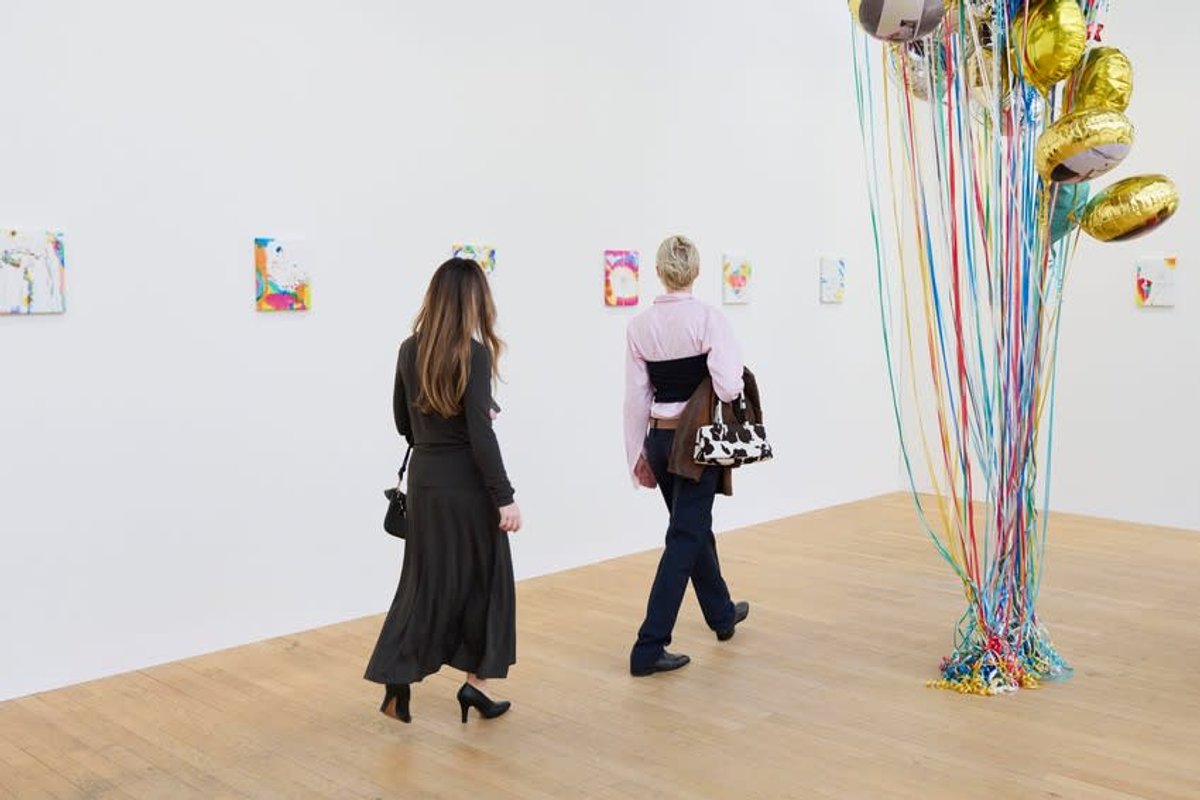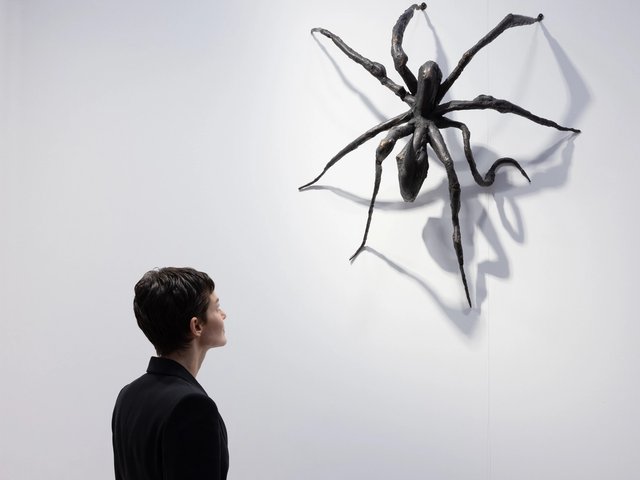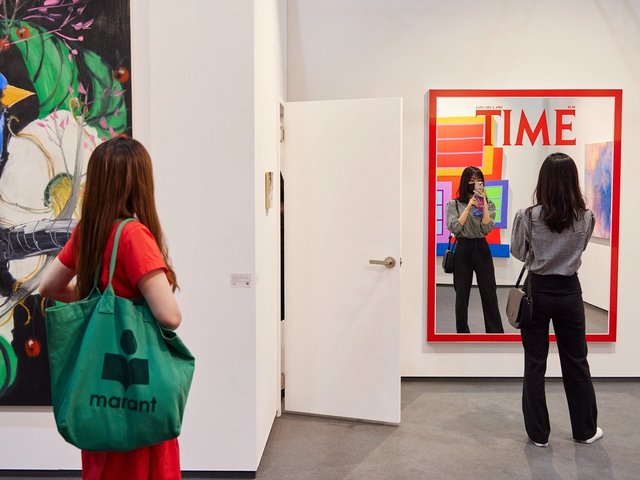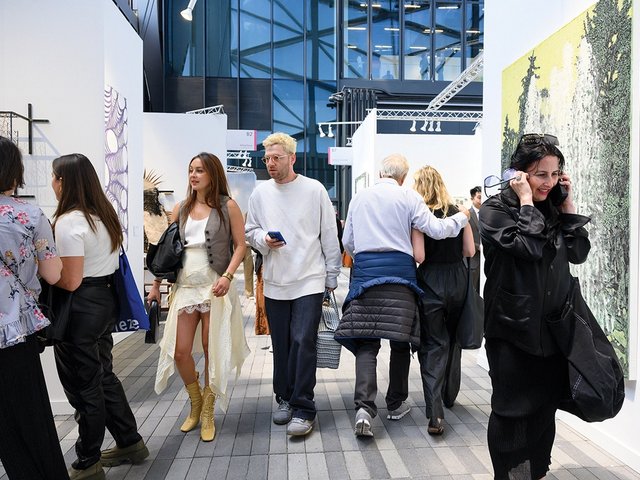Gender, age and attitudes to risk is the focus of the Art Basel and UBS Survey of Global Collecting 2025, released today. It finds that women appear to not only be spending more on art but are also more likely to buy work by an unknown artist than their male counterparts.
The 200-page-long report surveys 3,100 high net worth individuals (HNWIs)—who are active art buyers—in ten markets in mid-2025. The aim is simple: to establish who is buying what, where, from whom and for how much, so we might get a glimpse into where the market might be headed. Much of the market for “blue chip” art today is built upon the tastes of Boomer and Silent Generation collectors, largely male. But analysing the tastes and behaviours of Millennial and Gen Z buyers helps auction houses, galleries and fairs to predict what the next generation of collectors will want to buy.
Women are especially important—the report says that by the end of 2024, women controlled over a third of global wealth, a share that is rising fast. According to UBS’s 2025 Gender-Lens Investment Report, an estimated $32 trillion in global spending is managed by women and 75% of discretionary spending globally is expected to be controlled by them within five years.
Hence why the economist Clare McAndrew, the report’s author, was determined that this year’s sample would be evenly split between men and women in order to analyse gender differences in collecting habits, as well as covering a broad age range in order to assess how art buying might change with the next generation—74% of respondents were Millennial and Gen Z.
McAndrew stresses that these collecting reports are not “a temperature check of the market”, as is the case with the annual Art Basel and UBS Art Market Report, also written by McAndrew and published each spring. Instead, they take a broader group of wealthy people and ask them to self-assess their tastes and spending.
Generational divide
Although the pervading backdrop to the report is one of continued geopolitical and economic uncertainty, coupled with tariffs and increased impediments to cross border trade and freedom of movement, HNWI continued to actively spend on art, antiques and collectibles, according to the report. The HNWIs sampled spent an average of 20% of their wealth on their art collections (up from 15% in 2024), while ultra-high net worth individuals (UHNWIs) with over $50m in assets averaged 28%. Across all respondents, average spending totalled $438,990, with collectors buying an average of 14 works. Boomers, although the smallest sample, were the biggest spenders, at almost $993,000, followed by millennials at $523,000.
But, interestingly, Gen Z clients were spending comparatively more of their wealth on art (26%) and 90% of Gen Z respondents who had inherited works of art said they planned to keep them, while 80% across all age ranges planned to pass on their collections to their children.
Sneaker heads
The report also looked at how tastes and collecting priorities vary across generations. While Boomers tended to concentrate on buying paintings, the tastes of Millennials and Gen Z were broader. Millennials spent the most on decorative art, design and jewellery. And contrary to perceived wisdom that they are more interested in experiences than material possessions, Gen Z spent the most on average in all other sectors including handbags (on a level with Boomers), classic cars, boats, jets and five times that of other age groups on sneakers—that is $19,440 on average on second-hand shoes.
Despite the crash of the NFT market, digital art is surprisingly popular—23% of the HNWIs said they planned to buy digital art, up from 19% in the previous survey, with 26% of Gen Z collectors saying they planned to buy digital works.
But overall, across all ages and genders, paintings remain the most popular genre, with 48% of HNWIs planning to buy one over the next year, followed by sculptures at 37%. Gen Z respondents again appear the most acquisitive aside from Boomers, with 40% saying they planned to buy sculpture, higher than Gen X or Millennials. This painting and sculpture dominance played out across genders too, with 41% of women saying they planned to buy paintings and 22% sculpture, compared to 54% men planning to buy paintings and 40% sculpture. Women had higher interest than men in buying all mediums except paintings, sculptures and works on paper—for example photography, installations, textile-based art and digital art.
The last is an interesting one. Despite being a male-dominated area, the share of digital art in female HNWIs’ collections (at 15%) was higher than in men’s (at 11%).
Women are gaining increasing clout overall as collecting powers. In 2024 (the last full year of data), HNW women spent 46% more than their male peers, a phenomenon driven by Millennial and Gen Z women, who outspent their male peers. Millennial women said they spent an average of $643,700 in 2024, one of the highest overall, while Gen Z women spent $537,400, more than double that of men the same age. Millennial women in Mainland China had one of the highest annual spends, averaging $3.9m in 2024, while those in Japan spent just over $1m.
“Women are going to be a very powerful demographic,” McAndrew says. “Mainland China is always an outlier in these surveys, but when I see something consistently, year after year, in these surveys it means it’s quite a serious thing.” She adds: “Even though we talk a lot about a drop at the high end of the market, there are still these bizarrely high spending pockets, like these women in China, Japan and Brazil, too, who spend much more than their male counterparts.”
Past reports have not found a correlation between whether women are more likely to buy work made by women. But this latest report does—on average, 49% of works in the collections of women were by female artists, compared to 40% in men’s collections. In women’s collections in the US this rose to 55% and in Japan to 54%.
Risk takers
Contrary to the stereotype of women being more risk-averse—financially and otherwise—the report finds that female responded were more open to buying works by newly discovered, untested artists. In 2025, 55% of women said they had often or frequently bought works by unknown artists, compared to 44% of men, despite the fact that 52% of all participants said they viewed such acquisitions as high risk.
“We asked a whole series of questions on risk aversion in different areas, everything from financial and investment risk to social situations to healthcare, it was fascinating,” McAndrew tells The Art Newspaper. “I had to do a lot of background reading to frame the questions and all the academic papers say that women are more risk averse…Amy [Whitaker] made a very good point that it’s the consequences they face that make women more risk averse. When a man tries something, we say ‘oh well, he gave it a go’, whereas if I woman tries something and it doesn’t work, they often face more stringent critique.”
Whitaker, an Associate Professor at New York University in visual arts administration, and Roman Kräussl, a professor of finance at Bayes Business School, dig into the topic of gender differences in risk taking in their essay within the report. It is far from clear cut and risk is hard to quantify—as Whitaker and Kräussl point out: “Risk is implicitly tied to return, and return is judged differently by different people.”
McAndrew also makes the point that, regardless of gender, respondents tended to be more risk averse when it came to buying art compared to their financial investments: “It could be that art is more of a social thing, that if you turn out to buy something that’s a ‘dud’, it’s socially embarrassing and people might judge you, in a way they wouldn’t if you lost money on a fund.” This, McAndrew thinks, feeds into the superstar artist phenomenon, where many people buy a very narrow group of artists: “The biggest way to reduce risk is to just buy what everyone else is buying.”
Sales channels
The channels through which HNWIs prefer to buy is also delved into in the report. While the vast majority of sales were done through galleries and dealers (83% in 2024 and the first half of 2025), whether in person, online or at a fair, the percentage of those using auction to buy art dropped, from 74% in 2023 to 49% in 2024/25. The younger the collector, the less reliant they appear to be on traditional selling platforms such as auctions and galleries, preferring to buy more broadly through a range of means. And this plays into one of the biggest changes from previous surveys—the marked rise in direct from artist sales, now the second-most popular channel across all markets, according to the report.
Of all the HNWIs surveyed, 63% had bought works directly from an artist, a sharp rise from 27% in 2023 and 43% in 2022. Most of these sales were made through artists’ studios (43%), while 37% of HNWIs had commissioned a work (up from 15% in 2023) and 35% had bought works through Instagram.
“Direct from artist sales accounted for around 20% of spending, which is considerable,” McAndrew says. “If that is indicative of what is going on [in the market], then we will have to try and find a way to capture that data. There does seem to be an appetite among collectors for buying direct from artists.”
Overall, does McAndrew thinks there are signs of stabilisation in the market? “I think the fact that buying plans are ok, 40% of people are planning to buy art, is encouraging,” she says. “There seem to be pockets of really strong activity—Brazil, for instance, stood out. There’s more people planning to buy than planning to sell, which could be a sign of things building. There’s no indications it’s going to be a boom, but the report does show some stability.”





